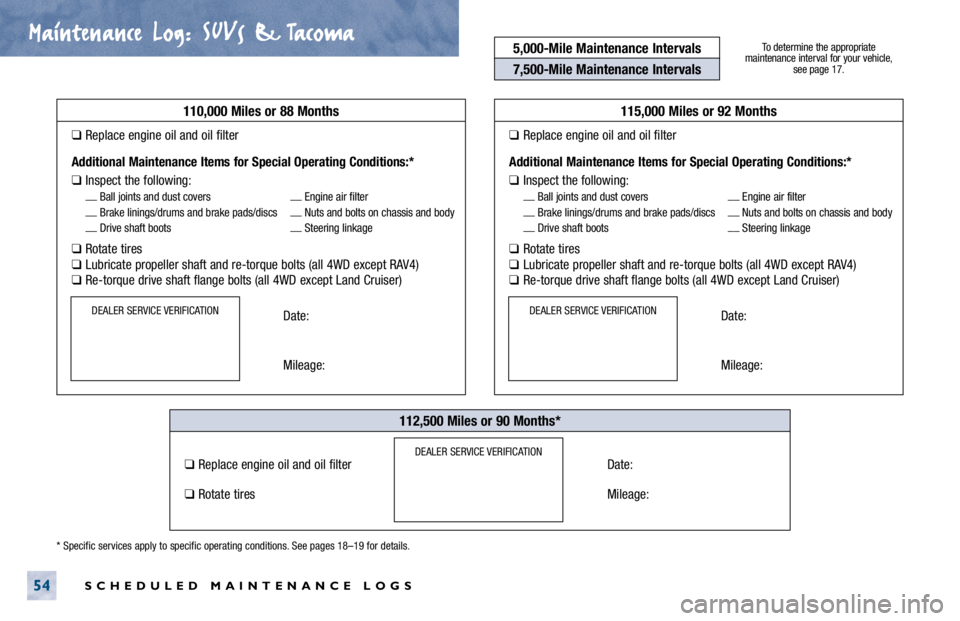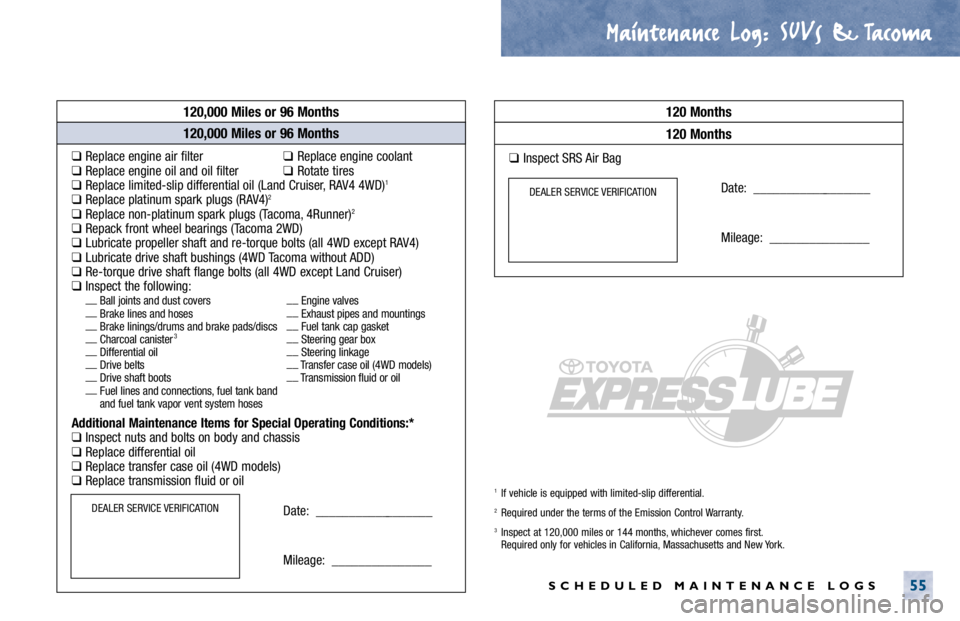Page 1146 of 4770

Maintenance Log.
. SUVs & Tacoma
SCHEDULED MAINTENANCE LOGS54
110,000 Miles or 88 Months
❑Replace engine oil and oil filter
Additional Maintenance Items for Special Operating Conditions:*
❑Inspect the following:__
Ball joints and dust covers__
Engine air filter
__
Brake linings/drums and brake pads/discs__
Nuts and bolts on chassis and body
__
Drive shaft boots__
Steering linkage
❑Rotate tires❑Lubricate propeller shaft and re-torque bolts (all 4WD except RAV4)❑Re-torque drive shaft flange bolts (all 4WD except Land Cruiser)
Date:
Mileage:
115,000 Miles or 92 Months
❑Replace engine oil and oil filter
Additional Maintenance Items for Special Operating Conditions:*
❑Inspect the following:__
Ball joints and dust covers__
Engine air filter
__
Brake linings/drums and brake pads/discs__
Nuts and bolts on chassis and body
__
Drive shaft boots__
Steering linkage
❑Rotate tires❑Lubricate propeller shaft and re-torque bolts (all 4WD except RAV4)❑Re-torque drive shaft flange bolts (all 4WD except Land Cruiser)
Date:
Mileage:
❑Replace engine oil and oil filter
❑Rotate tiresDate:
Mileage:
112,500 Miles or 90 Months*
DEALER SERVICE VERIFICATIONDEALER SERVICE VERIFICATION
DEALER SERVICE VERIFICATION
5,000-Mile Maintenance Intervals
7,500-Mile Maintenance Intervals
To determine the appropriate
maintenance interval for your vehicle,
see page 17.
* Specific services apply to specific operating conditions. See pages 18–19 for details.
Page 1147 of 4770

Maintenance Log.
. SUVs & Tacoma
SCHEDULED MAINTENANCE LOGS55
120,000 Miles or 96 Months
❑Replace engine air filter❑Replace engine coolant❑Replace engine oil and oil filter❑Rotate tires❑Replace limited-slip differential oil (Land Cruiser, RAV4 4WD)1
❑Replace platinum spark plugs (RAV4)2
❑Replace non-platinum spark plugs (Tacoma, 4Runner)2
❑Repack front wheel bearings (Tacoma 2WD)❑Lubricate propeller shaft and re-torque bolts (all 4WD except RAV4)❑Lubricate drive shaft bushings (4WD Tacoma without ADD)❑Re-torque drive shaft flange bolts (all 4WD except Land Cruiser)❑Inspect the following:__
Ball joints and dust covers__
Engine valves
__
Brake lines and hoses__
Exhaust pipes and mountings
__
Brake linings/drums and brake pads/discs__
Fuel tank cap gasket
__
Charcoal canister
3__
Steering gear box
__
Differential oil__
Steering linkage
__
Drive belts__
Transfer case oil (4WD models)
__
Drive shaft boots__
Transmission fluid or oil
__
Fuel lines and connections, fuel tank band
and fuel tank vapor vent system hoses
Additional Maintenance Items for Special Operating Conditions:*❑Inspect nuts and bolts on body and chassis❑Replace differential oil❑Replace transfer case oil (4WD models)❑Replace transmission fluid or oil
Date: __________________
Mileage: _______________
120,000 Miles or 96 Months
120,000 Miles or 96 Months
120 Months
DEALER SERVICE VERIFICATION
120 Months
❑Inspect SRS Air Bag
Date: __________________
Mileage: _______________
DEALER SERVICE VERIFICATION
1If vehicle is equipped with limited-slip differential.2Required under the terms of the Emission Control Warranty.
3Inspect at 120,000 miles or 144 months, whichever comes first.
Required only for vehicles in California, Massachusetts and New York.
Page 1154 of 4770
![TOYOTA CAMRY 2000 Service Repair Manual B
[A]: System Title
[B]: Indicates a Relay Block. No shading is used and
only the Relay Block No. is shown to distinguish it
from the J/B
Example : Indicates Relay Block No.1
[C]: ( ) is us TOYOTA CAMRY 2000 Service Repair Manual B
[A]: System Title
[B]: Indicates a Relay Block. No shading is used and
only the Relay Block No. is shown to distinguish it
from the J/B
Example : Indicates Relay Block No.1
[C]: ( ) is us](/manual-img/14/57447/w960_57447-1153.png)
B
[A]: System Title
[B]: Indicates a Relay Block. No shading is used and
only the Relay Block No. is shown to distinguish it
from the J/B
Example : Indicates Relay Block No.1
[C]: ( ) is used to indicate different wiring and
connector, etc. when the vehicle model, engine
type, or specification is different.
[D]: Indicates related system.
[E]: Indicates the wiring harness and wiring harness
connector. The wiring harness with male terminal is
shown with arrows (
).
Outside numerals are pin numbers.
Female Male ( )
The first letter of the code for each wiring harness
and wiring harness connector(s) indicates the
component's location, e.g, ºEº for the Engine
Compartment, ºIº for the Instrument Panel and
Surrounding area, and ºBº for the Body and
Surrounding area.
When more than one code has the first and second
letters in common, followed by numbers (e.g, IH1,
IH2), this indicates the same type of wiring harness
and wiring harness connector.
[F]: Represents a part (all parts are shown in sky blue).
The code is the same as the code used in parts
position.
[G]: Junction Block (The number in the circle is the J/B
No. and the connector code is shown beside it).
Junction Blocks are shaded to clearly separate
them from other parts.
3C indicates
that it is inside
Junction Block
No.3 Example:
���� ���� ���� ���� ���� ���� ����
[H]: When 2 parts both use one connector in common,
the parts connector name used in the wire routing
section is shown in square brackets [ ].[I]: Indicates the wiring color.
Wire colors are indicated by an alphabetical code.
B = Black W = White BR = Brown
L = Blue V = Violet SB = Sky Blue
R = Red O = Orange LG = Light Green
P = Pink Y = Yellow GR = Gray
G = Green
The first letter indicates the basic wire color and the
second letter indicates the color of the stripe.
Example: L ± Y
L
(Blue)Y
(Yellow)
[J]: Indicates a wiring Splice Point (Codes are ºEº for the
Engine Room, ºIº for the Instrument Panel, and ºBº
for the Body).
The Location of splice Point I 5 is indicated by the
shaded section.
[K]: Indicates a shielded cable.
[L]: Indicates the pin number of the connector.
The numbering system is different for female and
male connectors.
Example :
Numbered in order
from upper left to
lower rightNumbered in order
from upper right to
lower left
Female Male
[M]: Indicates a ground point.
The first letter of the code for each ground point(s)
indicates the component's location, e.g, ºEº for the
Engine Compartment, ºIº for the Instrument Panel
and Surrounding area, and ºBº for the Body and
Surrounding area.
[N]: Page No.
Page 1158 of 4770

B
The ºCurrent Flow Chartº section, describes which parts each power source (fuses, fusible links, and circuit breakers)
transmits current to. In the Power Source circuit diagram, the conditions when battery power is supplied to each system
are explained. Since all System Circuit diagrams start from the power source, the power source system must be fully
understood.
Theft Deterrent and Door Lock Control
K POWER SOURCE (Current Flow Chart)
11
1
EA1 1EA2 3
7
EB16
E 6
E 7I 2I 2
I 2
E 7
E 7
E 7
2
1
1
2
2
2
2
2
B
B
W W
B B B B BW±B
B
B
B B±O
B±W
W±B
B±W STARTER RELAY INJECTION RELAY15A HAZ±RADIO7.5A AM250A MAIN 1.25B FL MAIN
BATTERY
WWW
W W W
R W±L
W
W
G±W
G
15A TAIL
20A DEFOG
15A RAD CIGTA I L
RELAY 7.5A DOME 40A DOOR LOCK CB
2 1
1 2
4 8
2 3
3 4
G
W±R
P±L B±Y
B±Y
W±R
AM2 IG2
ACC
IG1AM1W W
W±R
W W
W±B
21
1
1
1
1
2
2
2
2
3
4
3
4 1
2
1
22
1
11
1
IGNITION SW I 8
Battery
30A AM2
2
Starter S 220A RADIO NO.1
10A HORN
15A EFI
7.5A DOMEShort Pin
10A HAZARD
The chart below shows the route by which current flows from the battery to each electrical source
(Fusible Link, Circuit Breaker, Fuse, etc.) and other parts.
Engine Room R/B (See Page 20)
ABS
ABS and Traction Control
Cruise Control
Electronically Controlled Transmission and A/T Indicator
Multiplex Communication System
Cigarette Lighter and Clock
Key Reminder and Seat Belt Warning STOP
Fuse Page
194
214
11 2
System
DOME 20A
10ACombination Meter
Headlight
Interior Light
2
2
6 100A ALT
EB1
POWER SOURCE
Light Auto Turn Off187
180
166
210
230
122
10A ECU±B
5 60A ABS
2
6 Fusible Link Block2
* The system shown here is an EXAMPLE ONLY. It is different to the actual circuit shown in the SYSTEM CIRCUITS SECTION.
Page 1167 of 4770
F RELAY LOCATIONS
[Engine Compartment]
[Body]
Page 1168 of 4770
F
[Instrument Panel]
Fusible Link BlockEngine Compartment Left (See Page 18)
(Inside Engine Room J/B No.2)
Page 1171 of 4770
F RELAY LOCATIONS
������ ���: Engine Room J/B No.2Engine Compartment Left (See Page 18)
Page 1172 of 4770
F
[Engine Room J/B No.2 Inner Circuit]